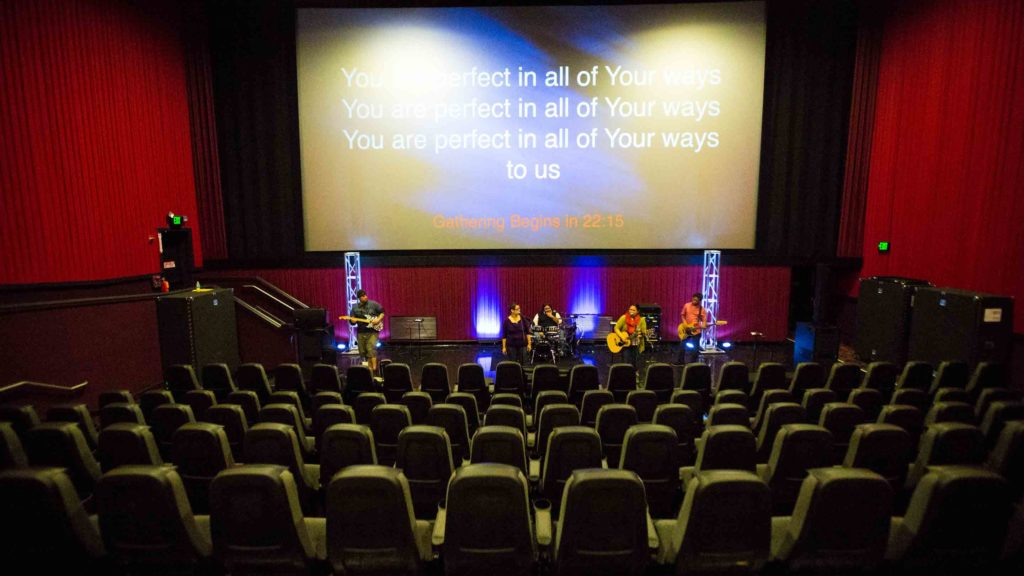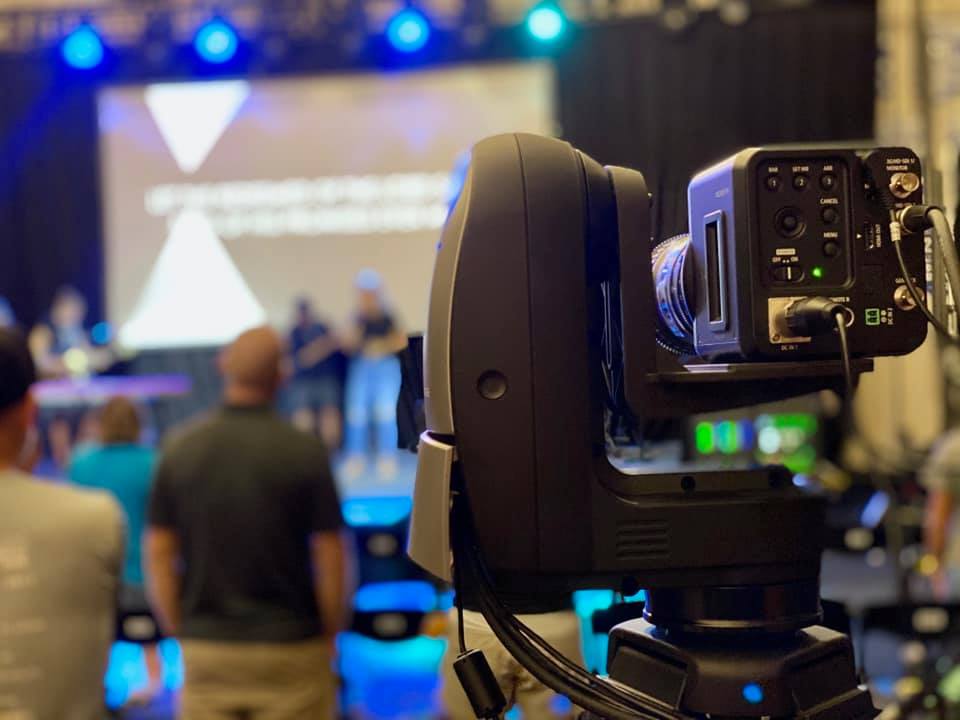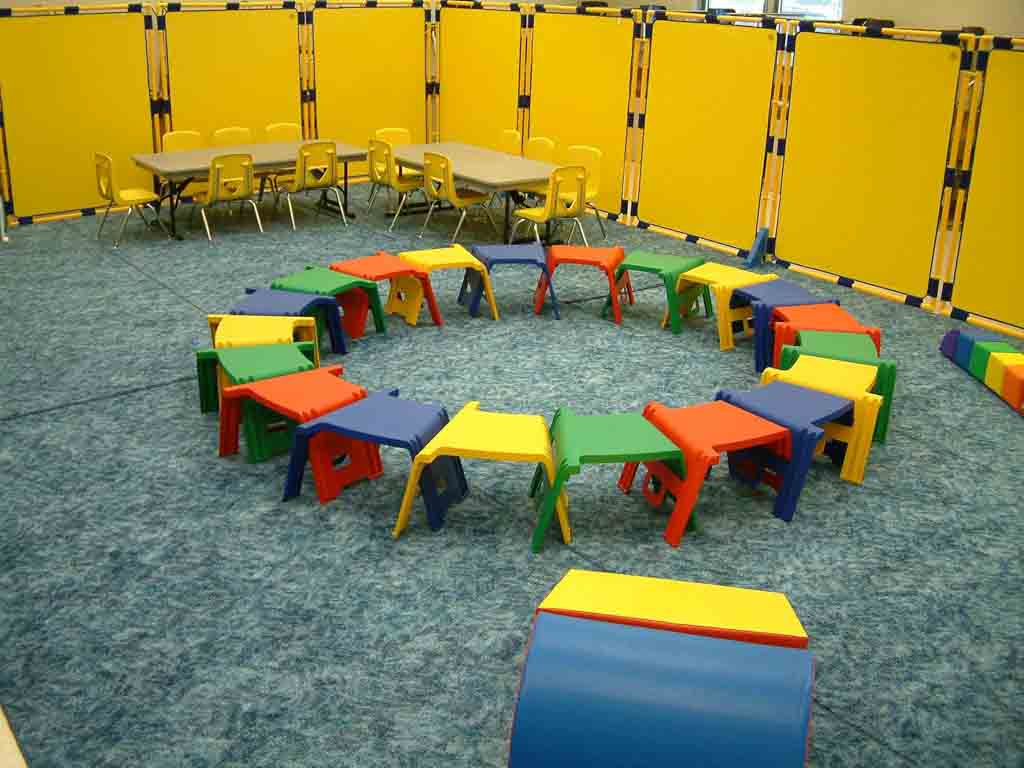Before you go portable, learn from those who have gone before you.
Calgary Life Church in Alberta had the perfect situation. They had a lease with an old movie theater that allowed them to update the building to suit their needs. They were running 1,000 adults comfortably and had room for upwards of 200 children every week. Unfortunately, they received word that they lost their building to a medical practice. Their lease was up.
Just like that, Calgary Life Church (CLC) found itself without a home. While they had already purchased 15 acres of land for a future church building, the ground had not been broken for construction, nor were there any immediate plans to do so.
This especially wasn’t good news for Ryan Resmer, the brand new music and media director for CLC. He had been at CLC for two weeks when the news of the terminated lease came. “It was crazy,” laughs Resmer. “…for all of us!”
The church was seven years into the building, running multiple services, youth programs, midweek services, ministry college classes, and a vibrant cafe ministry. “We didn’t know what we were going to do or even what our options were,” said Resmer.
LOCATION CONSIDERATIONS
There were many things to consider. Internationally known Senior Pastor, Anthony Greco, had worked hard to establish a multi-cultural ministry in Calgary. The search for a new location had to take this into account. Moving too far away from their original location would feel like starting over. The physical location of their church had to be close to their existing building and close to the public transit system. The physical properties of the location had to facilitate their energetic children’s ministry and a weekly TV broadcast (Pastor Greco had a long-established TV Ministry and his sermons were broadcast live from the new movie theater location).
CLC immediately began checking out all kinds of other venues to host what would become a mobile church and immediately struck out. Hotels, theaters, convention centers – anything that could accommodate their number of adults and children, was too expensive or too far away. “In our city, there were actually three locations that were large enough to hold us, but the cost was through the roof!” exclaimed Resmer.

Leaving A Building to Go Portable In A Movie Theater
That’s when CLC entered into a conversation with an operational movie theater just 1 kilometer from their current location. After a few conversations with the theater, it became clear that this was the new home for CLC. The theater was available, affordable, accommodating, and in the right location.
Now that they had a building, Resmer had his work cut out for him. As a team, their priorities were clear:
- The children’s ministry had to remain engaging enough for the children to “drive their parents out of bed on a Sunday morning to come to church.”
- Technology had to sound good and look good in person and remotely.
- They had to spend the least amount possible to get what they needed.
Planting Perks: 5 Benefits of Starting a New Church
Different Tech Requirements When You Go Portable
Going to a movie theater that sat only 440 people at a time, CLC realized that more than 50% of their people would not be accommodated. They came up with a unique solution. They would have three theaters for adults. The first theater would be completely live. Next, the second theater would pipe in a live feed of the sermon and of the worship band, which would be paired with live singers. Finally, the third theater would become a family-focused theater to accommodate young families and would be completely remote, piping in everything from announcements to teaching. Each theater would have live greeters and live volunteers to which people could ask questions, etc.
With this strategy, more than 50% of the church would experience a portion of the entire service by video, making video and lighting one of the most integral parts of their equipment solution.
With this in mind, Resmer and his team began exploring different equipment solutions. One of their first calls was to us – Portable Church Industries (PCI). “I had a lot of experience working with some large production companies, and I knew it was one thing to load a show in and out and another thing to produce something portable on a weekly basis,” he said. “I knew we needed experts.” CLC was immediately paired with Curt Banter, a design consultant and Bob Smith, Sr. Design Consultant from our team. Banter agreed that video and lighting were to be two of the most important things to harness, not only for those that would experience it in the movie theater but also for those who would experience CLC via broadcast media. “CLC needed to present something of broadcast quality coming out of a movie theater. From a quality standpoint, that was our foremost consideration,” he said.
Tech Solutions in a Portable Setup
The lighting and power questions were resolved internally to CLC. First, this was tackled by permanently installing some conventional lighting fixtures and secondly by installing additional power. The lighting is intelligent, with front lights and back lights. The whole operation takes less than 30 minutes to set up, which includes light and color balancing with the cameras.
“Our second objective with their equipment plan was to make sure we integrated as much of their existing technology as we could,” said Banter. “We didn’t want them to spend more money than they needed.” We were able to integrate much of CLC’s existing gear into a mobile church solution. “What we did was take their existing equipment, upgrade some and simplify others. It needed to become as simple as possible.” Churches who set up in movie theaters are captive to the movie times and thus, must enter and exit the building very quickly. An easy and efficient setup is imperative in this type of situation.
Love podcasts? Top 10 Podcasts for Church Planters
For the video portion of their solution, we built out a full broadcast set-up. CLC had been running an analog, standard definition system. The new, portable CLC system upgraded them to a digital HD system with a new switcher. “For us, video has been, hands-down, the biggest step forward for us. We thought doing a TV Show portably would be potentially disastrous and be put off the air,” expressed Resmer. “However, it’s actually been an improvement over what we had before. (The new video system) is extremely easy to set up and tear down and is unthreatening to new volunteers.”
The audio portion of the CLC design was created mostly from the equipment CLC had already in its possession. The biggest change in the audio considerations was drawing sound from the movie theater’s speaker system. “There were a few obstacles to overcome when connecting to the movie theater sound (editor’s note: adding bass and low end with a subwoofer), but we’ve been able to overcome those, and we are really happy with the way all three theaters sound.”
Considering Children’s Ministry In A Movie Theater
The children’s area was the next big task to tackle. “The children’s area was the biggest question mark in our minds,” says Resmer. ”We have an incredible children’s minister who is unbelievable in what she’s able to pull off.” It was important for CLC, as a team, to concentrate on the potential that portability could lend to their children’s ministry.
The one area that has improved for the CLC children’s ministry in portability was capacity. In
their new movie theater, they not only had a capacity for the 200 regular attendees but had capacity for even more, because they had the ability to expand into empty theaters. With all of the theaters available for rental to them with their new facility, CLC re-launched using only 50% of the available capacity for the children’s areas.
An unforeseen benefit of going portable is gaining more space for your congregation and children’s ministry. Getting to do more with less = WIN. Share on XAnother unforeseen advantage in going portable, in Resmer’s opinion, was the new drive to do more with less. According to him, there was so much change happening that it made CLC evaluate every decision and work really hard to think outside the box. An end result of those efforts manifested in CLC becoming stricter in purchasing decisions, which allowed them to mobilize their teams better.
On a family level, the addition of the family theater was well received. “We have about 20-30 families regularly attending in that theater,” says Resmer. “Families are able to worship corporately without feeling the pressure to keep kids from getting antsy or talking. It’s been a great addition to the CLC family offerings,” according to Resmer.
Be child-smart: 10 Smart Check-In Solutions for Portable Churches
Going Portable Requires Adjustments
The move from permanency to portability has been an adjustment, not just for Sunday services, but across the board, operationally. Pastor Greco, used to being in front of cameras in a larger venue, had to adjust to seeing much more in such a smaller venue. “He isn’t normally very distracted, but in our newer venue, he can see everything – like a camera operator flagging to a sound guy or someone walking behind a camera, “ said Resmer. These are things Greco has had to adjust to when preaching on camera in a portable environment.
Bigger than those distractions, however, are the space questions. Where can you accommodate:
- Midweek classes?
- A staff of 20 people have office space?
- The youth group on a Friday night?
- Your midweek services?
These were operational questions that were quite worrisome in the consideration of going portable. “The move to portability had us reevaluating every ministry from the ground up and asking ourselves, ‘Is this something that we even want to do?’ said Resmer. “What are the benefits of this ministry? What is the cost? What is the outcome? Can we find a facility for it?”
One fall-out from this re-evaluation phase was the cafe ministry. CLC had a Starbucks-style espresso bar and cafe. While they searched high and low for another facility that would accommodate college classes, youth ministry, offices, and midweek services in addition to a cafe, they couldn’t find one. The cafe ministry was cut from a thriving operation down to zero. “It’s been a big challenge, we had to rethink everything,” said Resmer.
For office space, CLC found a 21,000 sq. foot space with a loading dock that is only 500 meters from the movie theater. They are able to store their trailers and equipment there, as well as host all 20 staff members’ offices. In that space, they were also able to build out a stage area with lighting and acoustic treatment. This space will host their midweek services and their youth services as well as provide a space for the worship team to practice.

Introducing the Idea of ‘Going Portable’ to Your Congregation
Announcing the news to the congregation was another challenge and it was dealt with very delicately by CLC. “The first couple of days were ‘crisis mode’,” according to Resmer. “We called a meeting with 30 of our core leaders and explained the situation to them. We asked them to pray for the Lord to provide opportunities,” said Resmer.
Six or seven weeks later, after Resmer and his team had identified a new facility and PCI as an equipment provider, Greco brought the message to his congregation. This is an opportunity to step up and step forward, he challenged. A new building on their 15 acres was coming, as promised, but the Lord was leading them to this movie theater for at least the next 24–36 months.
“He was great,” said Resmer. “He’s a brilliant communicator and helped our people see that this was our best and most affordable option.” Greco’s message energized the CLC community.
In fact, most of the members of CLC stayed with the church through the transition, with less than 10% opting to leave for a more traditional Church setting. There were a few reasons for some making the decision to leave. A move to the theater meant a change in service times. For some, the new time wasn’t conducive to their family. For others, the decision to leave was a fear that CLC would be too different from what they were used to. “We have to give people that,” said Resmer. Losing people isn’t easy, but “they had a right to choose where they wanted to worship.”
Even with the prep work, the partnership with us at Portable Church Industries, and the momentum established by Greco and Resmer’s team, there were still some worrisome moments. The day before they were set to launch in the theater (one week after their last service in the permanent building), Resmer felt a bit of panic. “It was like, ‘Is this even going to work?’” he remembers.
Thankfully, their first weekend went off remarkably better than anticipated. “I remember telling volunteers on re-launch weekend, ‘This is just the beginning of something really big.’
“I wanted them to realize that this wasn’t the end of anything. It was the beginning of something,” said Resmer. “On Sunday, every volunteer showed up, everyone was willing to work, our teams were in place and we pulled it off.”
When your church goes portable, it isn’t the end of anything. It is the beginning of something. Share on XAre you ready for a new “beginning” too? Want to learn more about going portable or launching a multisite? We’d love to help.
We’d love to offer you a free, 30-minute consultation with one of our Church Launch Specialists. Book a call today to learn what your church would need to go portable.

































































